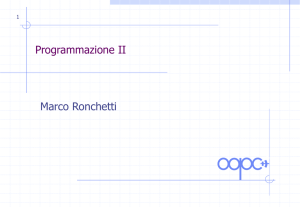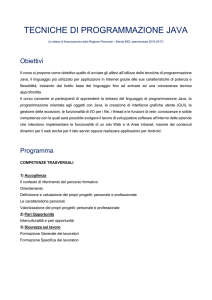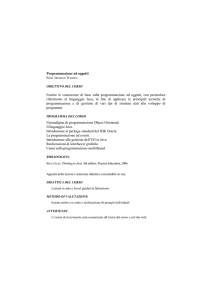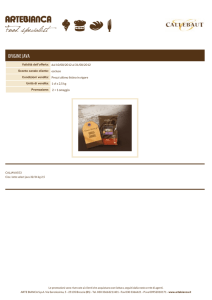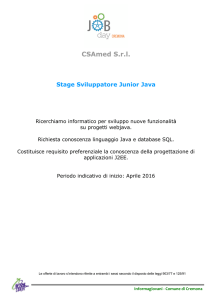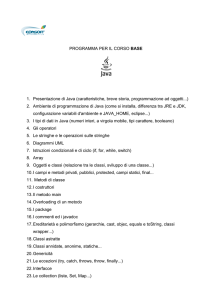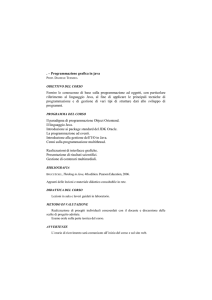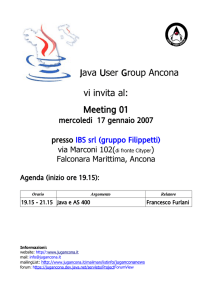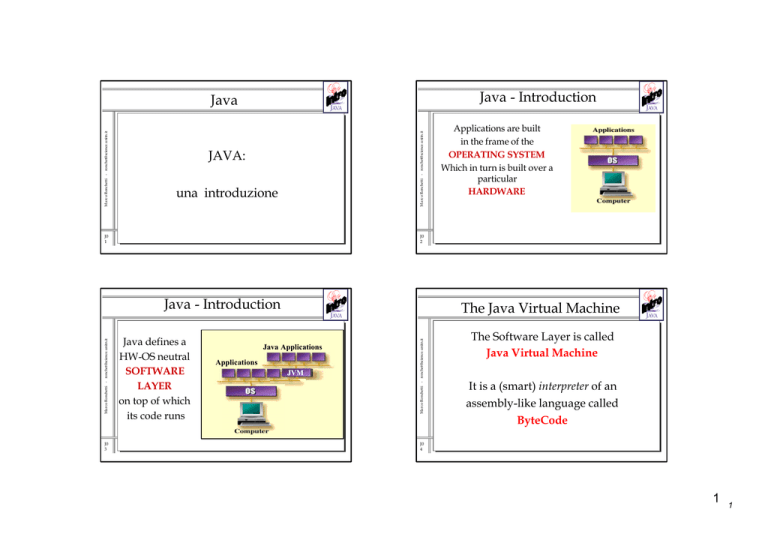
Java - Introduction
Marco Ronchetti - ronchet@science. unitn.it
Marco Ronchetti - ronchet@science. unitn.it
Java
JAVA:
una introduzione
J0
1
J0
2
Java defines a
HW-OS neutral
SOFTWARE
LAYER
on top of which
its code runs
The Java Virtual Machine
Java Applications
Applications
JVM
Marco Ronchetti - ronchet@science. unitn.it
Marco Ronchetti - ronchet@science. unitn.it
Java - Introduction
J0
3
Applications are built
in the frame of the
OPERATING SYSTEM
Which in turn is built over a
particular
HARDWARE
The Software Layer is called
Java Virtual Machine
It is a (smart) interpreter of an
assembly-like language called
ByteCode
J0
4
1
1
Compiler
(Pentium)
Compiler
(Mac)
Marco Ronchetti - ronchet@science. unitn.it
J0
5
J0
7
Executable
(Linux)
Executable
(Win32)
Linux
Windows 32
Marco Ronchetti - ronchet@science. unitn.it
C-code
Compiler
(Linux)
Portability of Java programs
Mac
Executable
(Mac)
Unix+JVM
Java-code
Compiler
(Unix)
Pentium +JVM
Compiler
(Pentium)
Bytecode
(Platform
independent)
Mac+JVM
Compiler
(Mac)
WRITE ONCE, RUN EVERYWHERE!
J0
6
“Executable” files can be dowloaded through the net
But… Java version problem… Solve with a Plug-In
Java based
NETWORK COMPUTER
The Java Virtual Machine
Why Java? A safer language
The Java Virtual Machine can:
be an application
live inside an application (e.g. a Browser)
live inside the Operating System (e.g.
JavaOS)
A clean object-oriented programming
language
No pointer arithmetic
Automatic Memory Management
(Garbage Collection)
Automatic array and string bounds
check
Marco Ronchetti - ronchet@science. unitn.it
Marco Ronchetti - ronchet@science. unitn.it
Traditional “portability” (ideal)
J0
8
2
2
!
Consists of:
re
ca
!
y
t
’
The language Eas
on
ud
e
o
th rt!
The Virtual Machine Y
t’s lt pa
a
Th cu
(Many) class libraries and API diffi
Java: the platform for “Internet Computing”
Hardware independent
• Scalable
Facilità
Java è basato sul C, come il C++.
Marco Ronchetti - ronchet@science. unitn.it
Marco Ronchetti - ronchet@science. unitn.it
“the first universal software platform”
• Open
J0
9
J0
10
•Java TOGLIE al C alcune caratteristiche difficili e pericolose
(puntatori).
•Java AGGIUNGE al C le caratteristiche di un linguaggio object oriented (classi, ereditarietà, messaggi).
•Java INTRODUCE una gerarchia di classi predefinite:
AWT, IO, Lang(tipi, Math, Thread), Exeptions, Net,
Utils(Vector, Dictionary, Date...)
Java ha:
J0
11
La maggior parte degli errori sono legati alla gestione della
memoria tramite i PUNTATORI:
•puntatori che puntano a locazioni illecite (non allocate)
•puntatori che puntano a locazioni lecite ma sbagliate
•indirizzi di vettori sbagliati
•memoria allocata e non più rilasciata (memory leaks)
Soluzione di Java:
•ABOLIZIONE DEI PUNTATORI
•GARBAGE COLLECTION
Marco Ronchetti - ronchet@science. unitn.it
Marco Ronchetti - ronchet@science. unitn.it
Robustezza
•eccezioni
(Ada, C++)
•Garbage Collection (LISP, Smalltalk)
•libreria di classi (da Smalltalk, Objective-C)
Le specifiche del linguaggio e della Java
Virtual Machine sono PUBBLICHE
J0
12
3
3
Storia di Java
Cos’e’ un eseguibile Java?
target: intelligent consumer electronics.
§ Successivamente, nuovo target: set top box
§ 1994: linguaggio per la “Web” (client side)
§ 1996: la prospettiva é “network computing”
Oak
Java
Oggi:
Successi
§ Device-independent GUI
§ Web on the server side (Servlets, JSP, EJB, XML…)
Marco Ronchetti - ronchet@science. unitn.it
Marco Ronchetti - ronchet@science. unitn.it
§ Inizio anni 90: Java nasce come “Oak”
Prospettive
J0
13
intelligent consumer electronics + smartcards
Il “Java processor” viene emulato via software. (Come il PPC
emula il 68040 su Mac...).
J0
14
Applicazioni
Marco Ronchetti - ronchet@science. unitn.it
Marco Ronchetti - ronchet@science. unitn.it
J0
15
Non esiste un processore con bytecode ad hardware!
(Sun lo aveva annunciato)
Il bytecode viene “interpretato”, o eseguito da “Just In Time”
Compilers.
Esecutori di bytecode
Java può essere eseguito:
•come standalone program
ü da interpreti java (o compilatori JIT, o Java Chips)
•come “applet”:
üda browsers Web:
üda applicativi ad hoc:
•come “add-on module”:
üda server Web
üda application server (Enterprise Java Beans)
E’ un codice “ByteCode”: istruzioni (assembler) di una
macchina virtuale (Java Virtual Machine).
Definizione:
Programmi stand-alone scritti in linguaggio Java.
Possono essere eseguiti da una Java Virtual Machine:
§ Fisica: un processore il cui assembler e’ il bytecode
§ Virtuale: un interprete o Just In Time Compiler Java.
J0
16
4
4
Hello World (application)
Hello World (application)
class HelloWorld {
/* Hello World, my first Java application */
public static void main (String args[]) {
System.out.println("Hello World!");
// qui va il resto del programma principale
}
Marco Ronchetti - ronchet@science. unitn.it
Marco Ronchetti - ronchet@science. unitn.it
Lo schema MINIMO di ogni applicazione é:
Lo schema CONSIGLIATO di ogni applicazione é:
class Applicazione{
/* Hello World, my first Java application - second version*/
public static void main (String args[]) {
Applicazione p= new Applicazione();
}
Applicazione() {
System.out.println("Hello World!");
// qui va il resto del programma principale
}
}
J0
18
Uso di JDK
Marco Ronchetti - ronchet@science. unitn.it
Compilazione:
J0
19
Obbligatorio
specificare
l’estensione!
$javac HelloWorld.java
produce HelloWorld.class
(in realtà: un file class per ogni classe contenuta nel
sorgente)
Esecuzione…
$java HelloWorld
Obbligatorio
omettere
l’estensione!
(la classe indicata deve contenere il main)
}
Applets
Marco Ronchetti - ronchet@science. unitn.it
J0
17
J0
20
Definizione:
Speciali programmi Java (senza “main”) richiamabili
dal linguaggio HTML ed eseguiti in un contesto
grafico.
Possono essere eseguiti da:
» Browser: un visualizzatore HTML dotato di interprete Java
» Programmi ad-hoc: visualizzatori di applets
(Es. AppletViewer)
5
5
J0
21
Uso di JDK + Appletviewer
HelloWorldApplet.java
/* First Hello World Applet */
import java.awt.Graphics;
public class HelloWorldApplet extends java.applet.Applet {
public void paint(Graphics g) {
g.drawString("Hello world!", 5, 25);
}
}
HelloWorldApplet.html
<HTML> <HEAD> <TITLE>Hello to everyone </TITLE> </HEAD> <BODY>
My Java Applet says:
<APPLET CODE="HelloWorldApplet.class" WIDTH=200 HEIGHT=75>
Il tuo browser non è abilitato per le applets </APPLET>
</BODY> </HTML>
Marco Ronchetti - ronchet@science. unitn.it
Marco Ronchetti - ronchet@science. unitn.it
Hello World (applet)
Compilazione e esecuzione:
$javac HelloWorldApplet.java
$appletviewer HelloWorldApplet.html
NOTA:
l’html NON viene
interpretato, se non
per la tag APPLET!
J0
22
Esecuzione tramite Browsers
J0
23
file:///.../ HelloWorldApplet.html
Ms Explorer
SunSoft Hotjava
Mosaic...
Netscape
Navigator
(Communicator)
NOTA:
l’html viene
interpretato
interamente
import java.awt.Graphics;
Marco Ronchetti - ronchet@science. unitn.it
Marco Ronchetti - ronchet@science. unitn.it
Loading file:
HelloAgainApplet
import java.awt.Font;
import java.awt.Color;
public class HelloAgainApplet extends java.applet.Applet {
Font f = new java.awt.Font("TimesRoman",Font.BOLD,36);
public void paint(Graphics g) {
g.setFont(f);
g.setColor(Color.red);
g.drawString ("Hello again!", 5, 50);
}
}
J0
24
6
6
http://www.java.sun.com/j2se/
JavaTM 2 Platform, Standard Edition (J2SETM)
The essential Java 2 SDK, tools, runtimes, and APIs for
developers writing, deploying, and running applets and
applications in the Java programming language. Also includes
earlier Java Development Kit versions JDKTM 1.1 and JRE 1.1
J0
25
Advanced development tool
Marco Ronchetti - ronchet@science. unitn.it
Marco Ronchetti - ronchet@science. unitn.it
Basic tools
J0
26
Advanced development tool
“The” Tutorials and examples
http://java.sun.com/docs/books/tutorial/?frontpage-spotlight
-- IBM Websphere, Application Server
-- IBM Developer Kits(JDKs) & Runtime Environment
-- Advanced Edition IBM Websphere Studio,
-- Entry Edition VisualAge forJava,
-- Entry Edition DB2 Universal Database Enterprise Edition
-- IBM HotMedia Software for the Java Environment
Marco Ronchetti - ronchet@science. unitn.it
Receive a Free copy of the developerWorks‘ Developer Toolbox Sample
CD, which includes:
Marco Ronchetti - ronchet@science. unitn.it
http://www.borland.com/jbuilder/foundation/
-- IBM alphaWorks Java and XML Software Technologies
J0
27
http://www.alphaworks.ibm.com/aw.nsf/html/devtoolscd?open&l=edu,t=gr,p=toolsCD
J0
28
7
7
http://www.phrantic.com/scoop/onjava.html
Free IBM developerWorks Online Java
Tutorials Homepage
Un buon libro…
Marco Ronchetti - ronchet@science. unitn.it
Marco Ronchetti - ronchet@science. unitn.it
More Tutorials and examples
Gratis in forma elettronica:
Thinking in Java
Bruce Eckel
http://www.eckelobjects.com/javabook.html
http://www2.software.ibm.com/developer/education.nsf/dw/javaonlinecourse-bytitle?open&l=edu,t=gr,p=javaeduhp
J0
29
J0
30
J0
31
The core API gives you the following features:
The Essentials: Objects, strings, threads, numbers,
input and output, data structures, system properties,
date and time, and so on.
Applets: The set of conventions used by Java applets.
Networking: URLs, TCP and UDP sockets, and IP
addresses.
Internationalization: Help for writing programs that
can be localized for users worldwide. Programs can
automatically adapt to specific locales and be displayed
in the appropriate language.
The Core Class libraries -2
Marco Ronchetti - ronchet@science. unitn.it
Marco Ronchetti - ronchet@science. unitn.it
The Core Class libraries -1
J0
32
Security: Both low-level and high-level,
including electronic signatures, public/private
key management, access control, and
certificates.
Software components: Known as JavaBeans, can
plug into existing component architectures such
as Microsoft's OLE/COM/Active-X
architecture, OpenDoc, and Netscape's Live
Connect.
8
8
JDK API
Object serialization: Allows lightweight persistence
and communication via Remote Method Invocation
(RMI).
Java Database Connectivity (JDBC): Provides uniform
access to a wide range of relational databases.
Java not only has a core API, but also standard
extensions. The standard extensions define APIs for 3D,
servers, collaboration, telephony, speech, animation,
and more.
J0
33
Marco Ronchetti - ronchet@science. unitn.it
Marco Ronchetti - ronchet@science. unitn.it
The Core Class libraries -3
J0
34
Marco Ronchetti - ronchet@science. unitn.it
JDK API
Marco Ronchetti - ronchet@science. unitn.it
JDK API
J0
35
J0
36
9
9
?(Java == ((C++)- -)++)
Forma di un programma
Marco Ronchetti - ronchet@science. unitn.it
Marco Ronchetti - ronchet@science. unitn.it
Differenze tra Java e C++
In Java tutto e’ una “classe”.
Lo scheletro minimo di un programma e’:
import . . . ;
class myProgram {
public s t a t i c v o i d main (String a r g s []) {
...
}
}
import <= Include “intelligente”
(senza bisogno di #ifdef)
NON c’è precompilatore!
J0
37
J0
38
I programmi Java includono nomi per identificare
alcune entità di programmazione
(packages, classes, interfaces, methods, variables,
statement)
Nomi validi sono composti da un numero illimitato di
lettere e numeri UNICODE, iniziare con una lettera.
Keywords
Le keywords usate attualmente sono
Marco Ronchetti - ronchet@science. unitn.it
Marco Ronchetti - ronchet@science. unitn.it
Nomi
Oltre a queste, alcune keywords sono riservate
per usi futuri:
by value cast const future generic goto inner operator
outer rest var
I nomi non possone essere Java keywords.
J0
39
abstract boolean break byte case catch char class
continue default do double else extends final finally float
for generic if implements import instanceof int interface
long native new null package private protected public
return short static super switch synchronized this throw
throws transient try void volatile while
J0
40
10
10
Commenti
Tipi di dato primitivi
/*
C style */
/* Questo tipo di commento
può proseguire su pi linee */
/* NOTA: ATTENZIONE AI /*COMMENTI*/ NIDIFICATI! */
// C++ style
// Una intera riga commentata
a=a+3; // Commento su una linea di codice
/**documentation */
/**Stile di commento usato da JAVADOC
Marco Ronchetti - ronchet@science. unitn.it
Marco Ronchetti - ronchet@science. unitn.it
3 forme di commento:
per la generazione automatica di documentazione
*/
J0
41
Type
boolean
char
Byte
short
int
Contains
true or false
Unicode char
signed integer
signed integer
signed integer
Default
false
\u0000
0
0
0
Size
1 bit
16 bits
8 bits
16 bits
32 bits
long
signed integer
0
64 bits -9223372036854775808/
9223372036854775807
float
IEEE 754 f.p.
0.0
32 bits +/-3.40282347E+38/
+/-1.40239846E-45
double IEEE 754 f.p.
0.0
64 bits +/-1.79769313486231570E+308/
+/-4.94065645841246544E-324
J0
42
Java characters, strings, and identifiers are composedof 16-bit Unicode
characters. This makes Java programs relatively easy to internationalize for
non-English-speaking users.
Most platforms cannot display all 38,885 currently defined Unicode
characters
The Unicode character set is compatible with ASCII and the first 256
characters (0x0000 to 0x00FF) are identical to the ISO8859-1 (Latin-1)
characters 0x00 to 0xFF.
Unicode \u escape sequences are processed before the other escape
characters
Literals (costanti)
interi (sempre int, long se serve)
0777 ottale
Marco Ronchetti - ronchet@science. unitn.it
Marco Ronchetti - ronchet@science. unitn.it
Unicode
J0
43
Min/Max Value
N.A./N.A.
\u0000/\uFFFF
-128/127
-32768/32767
-2147483648/2147483647
0xFF esadecimale
77L long
reali
10.4 1.04E01 double
10.4F 1.04E01F float
boolean
true
false
carattere
tutte le escape sequences del C sono riconosciute (\n \t \’ \” \\ …)
Unicode: \u0022 has exactly the same meaning to the compiler as "
stringhe
“questa e’ una stringa”
J0
44
11
11
Strings in Java are not a primitive type, but are instances of the
String class.
However, because they are so commonly used, string literals may
appear between quotes in Java programs, just as they do in C:
“pippo”
When the compiler encounters such a string literal, it automatically
creates the necessary String object.
J0
45
Operatori
Marco Ronchetti - ronchet@science. unitn.it
Marco Ronchetti - ronchet@science. unitn.it
String Literals
Operatori
comparazione
unitari
algebrici
postfissi
= =, !=, <, <=, >, >=
+, +, -, *, /, %
++, --
Bit
shift
bitwise comparison
<<, >>, >>>
~, &, |, ^
Boolean
relationali
logici
= =, !=
!, &, |, ^, &&, ||
String
concatenazione
+
Since Java does not allow you to manipulate pointers directly,
it does not support the reference and dereference operators *, >, and &, nor the sizeof operator. Further, Java doesn't
consider [] (array access) and . (field access) to be operators.
Java also adds some new operators:
The + operator applied to String values concatenates them. If
only one operand of + is a String, the other one is converted to
a string.
Java does not support operator overloading--the language
designers decided (after much debate) that overloaded
operators were a neat idea, but that code that relied on them
became hard to read and understand.
Operatori
Marco Ronchetti - ronchet@science. unitn.it
Marco Ronchetti - ronchet@science. unitn.it
Funzione
J0
46
Operatori
J0
47
Gruppo
Arithmetic
The instanceof operator returns true if the object o on its lefthand side is an instance of the class C or implements the
interface I specified on its right-hand side.
It also returns true if o is an instance of a subclass of C or is an
instance of a subclass of some class that implements I.
instanceof returns false if o is not an instance of C or does not
implement I.
It also returns false if the value on its left is null.
If instanceof returns true, it means that o is assignable to
variables of type C or I. The instanceof operator has the same
precedence as the <, <=, >, and >= operators.
J0
48
12
12
Java, come tutti i linguaggi OO, permette di definire
NUOVI TIPI DI DATO (classi).
Alcuni tipi di dato (classi) sono predefinite:
ad esempio le stringhe. (String)
Operatore
identificatore
costruttore
tipo
di creazione
Point punto = new Point(10,10);
No Structures or Unions
“Java non ha i puntatori”
Ma è vero?
Point punto = new Point(10,10);
Marco Ronchetti - ronchet@science. unitn.it
Marco Ronchetti - ronchet@science. unitn.it
Tipi di dato derivati (reference data)
l’identificatore di un oggetto (“punto”)
é un puntatore!
Quel che Java non ha è
l’aritmetica dei puntatori
Java does not support C struct or union types. Note, however, that a class is
essentially the same thing as a struct, but with more features. And you can
simulate the important features of a union by subclassing.
J0
49
.
J0
50
Variabili di istanza
Confronto dell’operatore new
in C++:
in Java:
Point * punto = new Point(10,10);
Point
punto.x di Java
punto = new Point(10,10);
equivale a
punto->x del C++
In Java gli oggetti sono accessibili
SOLO per referenza
Marco Ronchetti - ronchet@science. unitn.it
Marco Ronchetti - ronchet@science. unitn.it
/* creating objects then testing and modifying t h i e r IVs. */
i m p o r t j a v a . awt.Point;
class TestPoint {
public static void main (String a r g s []) {
P o i n t thePoint = n e w P o i n t ( 1 0 , 1 0 ) ;
S y s t e m . o u t . println ("x is " + thePoint. x ) ;
S y s t e m . o u t . println ("y is " + thePoint. y ) ;
S y s t e m . o u t . println ("Setting x to 5.");
t h e P o i n t .x = 5;
S y s t e m . o u t . println ("Setting y to 15.");
t h e P o i n t .y = 15;
S y s t e m . o u t . println ("x is " + thePoint. x ) ;
S y s t e m . o u t . println ("y is " + thePoint. y ) ;
J0
51
.
}
J0
52
}
13
13
Marco Ronchetti - ronchet@science. unitn.it
Una semplice classe con:
•due variabili d’istanza
•un costruttore
•un metodo
public static void main (String a r g s []) {
Person p;
2
p = new Person("Laura", 20);
class Person {
String name;
Method overloading 1
p.printPerson();
1
S y s t e m . o u t . println ( " --------" ) ;
int a g e ;
p = new Person("Tommy", 3);
p.printPerson();
Person(String n, int a ) {
S y s t e m . o u t . println ( " --------" ) ;
name = n;
}
age = a;
}
Marco Ronchetti - ronchet@science. unitn.it
Una semplice classe
}
this.x1 = x1;
this.y1 = y1;
this.x2 = x2;
this.y2 = y2;
/* rectangle class
MyRect buildRect(Point topLeft, Point bottomRight) {
to demonstrate
x1 = topLeft.x;
p o l y m o r p h i c methods */
y1 = topLeft.y;
x2 = bottomRight.x;
y2 = bottomRight.y;
i m p o r t j a v a . awt.Point;
return this;
}
class M y R e c t {
MyRect buildRect(Point topLeft, int w, int h) {
int x 1 = 0 ;
void p r i n t P e r s o n () {
System.out.print("Hi, my name is " + name);
J0
54
S y s t e m . o u t . println ( " . I a m " + a g e + " y e a r s o l d . " ) ;
y1 = topLeft.y;
int x 2 = 0 ;
x2 = (x1 + w);
int y 2 = 0 ;
y2 = (y1 + h);
return this;
}
Overloading di costruttore
void printRect(){
System.out.print("MyRect : <" + x1 + ", " + y1);
3
/* create news dates using various different ways */
System.out.println(", " + x2 + ", " + y2 + ">");
import java.util.Date;
Marco Ronchetti - ronchet@science. unitn.it
}
Marco Ronchetti - ronchet@science. unitn.it
x1 = topLeft.x;
1
}
Method overloading 2
2
return this;
}
int y 1 = 0 ;
J0
53
MyRect buildRect(int x1, int y1, int x2, int y2) {
Un esempio di
overloading
(polimorfismo)
public static void main (String args[]) {
MyRect rect = new MyRect ();
System.out.println("Calling buildRect with coordinates 25,25 50,50:");
rect.buildRect (25, 25, 50, 50);
rect.printRect ();
System.out.println(" ---------- ");
System.out.println("Calling buildRect w/points (10,10), (20,20):");
rect.buildRect (new Point(10,10), new Point(20,20));
rect.printRect ();
System.out.println(" ---------- ");
System.out.print("Calling buildRect w/1 point (10,10),");
class C r e a t e D a t e s {
public static void main (String a r g s []) {
Date d1, d2, d3;
d1 = new Date();
S y s t e m . o u t . println ("Date 1: " + d1);
d2 = new Date(71, 7, 1, 7, 30);
S y s t e m . o u t . println ("Date 2: " + d2);
System.out.println(" width (50) and height (50)");
rect.buildRect (new Point(10,10), 50, 50);
rect.printRect ();
d3 = new Date("April 3 1993 3:24 PM");
4
S y s t e m . o u t . println ("Date 3: " + d3);
System.out.println(" ---------- ");
J0
55
}
}
}
J0
56
}
14
14
Riferimenti ad Oggetti
Confronto tra oggetti
/* compare two different strings using equals */
/* testing references; change one, the other changes.*/
class EqualsTest {
public static void main (String args []) {
class R e f e r e n c e s T e s t {
public static void main (String a r g s []) {
Point pt1, pt2;
pt1 = new Point(100,100);
pt2 = pt1;
pt1.x = 200;
pt1.y = 200;
Marco Ronchetti - ronchet@science. unitn.it
Marco Ronchetti - ronchet@science. unitn.it
i m p o r t j a v a . awt.Point;
String str1, str2;
str1 = "she sells sea shells by the sea shore.";
str2 = str1;
System.out.println("String1: " + str1);
System.out.println("String2: " + str2);
System.out.println("Same object? " + (str1 == str2));
str2 = new String(str1);
System.out.println("String1: " + str1);
System.out.println("String2: " + str2);
S y s t e m . o u t . println ("Point1: " + pt1.x + "," + pt1.y);
System.out.println("Same object? " + (str1 == str2));
S y s t e m . o u t . println ("Point2: " + pt2.x + "," + pt2.y);
System.out.println("Same value? " + str1.equals(str2));
}
J0
57
}
J0
58
}
subclassing & overriding
}
Classi e sottoclassi
class PrintSubClass extends PrintClass {
int z = 3;
/* superclass for testing
class NamedPoint extends Point {
String name;
NamedPoint(int x , int y, String name) {
super(x,y);
this.name = name;
this indica
l’oggetto
corrente
}
public void printName() {
System.out.println("Name is " + this.name);
}
public static void main (String arg[]) {
NamedPoint np = new NamedPoint (5, 5, "SmallPoint");
}
void printMe () {
System.out.println("X is " + x + ", Y is " + y);
System.out.println("I am an instance of the class" +
this.getClass ().getName ());
}
}
/* subclass for testing method overrides */
class PrintSubClass2 extends PrintClass {
int z = 3;
void printMe () {
2
System.out.println("x is " + x + ", y is " + y + ", z is " + z);
System.out.println("I am an instance of the class " +
this.getClass (). getName ());
}
public static void main (String args []) {
np.printName();
}
3
}
int y = 1;
System.out.println("Y is " + n p.y);
}
obj. printMe();
int x = 0;
System.out.println("X is " + n p.x);
J0
59
PrintSubClass obj = new PrintSubClass ();
1
class PrintClass {
Marco Ronchetti - ronchet@science. unitn.it
Marco Ronchetti - ronchet@science. unitn.it
import java.awt.Point;
super indica la
superclasse
public static void main (String args []) {
method overrides */
PrintSubClass2 obj = new PrintSubClass2();
J0
60
obj. printMe();
}
}
15
15
Reference Type Summary
memory management
and arrays are handled by reference in Java. (Those object
references are passed-by-value to methods, however.)
• The = and == operators assign and test references to objects.
and equals() to actually copy or test the objects themselves.
Use clone()
• The necessary referencing and dereferencing of objects and arrays is
handled automatically by Java.
• A reference type
can never be cast to a primitive type.
• A primitive type can never be
• There is no pointer
cast to a reference type.
arithmetic in Java.
• There is no sizeof operator in Java.
• null is a special value that means "no object" or indicates an absence
J0
61
reference .
Marco Ronchetti - ronchet@science. unitn.it
Marco Ronchetti - ronchet@science. unitn.it
• All objects
of
J0
62
Operazioni da eseguirsi alla nascita di un oggetto vanno
definite nel metodo “costruttore”.
Ogni classe deve avere uno (o piu’) costruttori.
Operazioni da associarsi con l’eliminazione di un oggetto
possono essere definite nel metodo “distruttore” finalize()
(opzionale)
GC interviene quando serve memoria.
GC elimina gli oggetti per i quali non vi sono piu’ riferimenti
attivi.
GC puo’ essere attivato su richiesta esplicita: System.gc()
Arrays
Marco Ronchetti - ronchet@science. unitn.it
Marco Ronchetti - ronchet@science. unitn.it
memory management
La gestione (dinamica) della memoria e’ automatica, tramite
creazione (operatore new ) e
§ la distruzione (garbage collection) di oggetti.
§ la
E’ possibile definire arrays di tutti i tipi di dati (elementari o
classi). In fase di DEFINIZIONE non e’ necessario specificare
la dimensione del vettore.
Solo al momento della ALLOCAZIONE viene richiesto lo
spazio desiderato.
String[ ] strings; // this variable can refer to any String array
strings = new String[10]; // one that contains 10 Strings
strings = new String[20]; // or one that contains 20.
float f[ ][ ] = new float[5][3]; //array bidimensionale
char s[]={'+','-','*','/','=','C'}; // array inizializzato in creazione
J0
63
J0
64
16
16
Metodi della classe Stringa
Marco Ronchetti - ronchet@science. unitn.it
Marco Ronchetti - ronchet@science. unitn.it
java.util
class TestString {
public static void main (String args []) {
String str = “ Nel mezzo del cammin di nostra vita";
System.out.println("The string is: " + str);
System.out.println("Length of this string: " + str .length());
System.out.println("The character at position 5: " + str. charAt (5));
System.out.println("The substring from positions 11 to 17: " +
str.substring(11,17));
System.out.println("The index of the character d: " + str. indexOf('d'));
System.out.println("The index of the beginning of the substring \”cammin\ ": "
+ str .indexOf(” cammin "));
System.out.println("The string in upper case: " + str .toUpperCase());
}
J0
65
J0
66
Valore in uscita
/ * sum a n d average command lines * /
class SumAverage {
public s t a t i c v o i d m a i n ( String args []) {
i n t s u m = 0;
float avg = 0;
f o r ( i n t i = 0; i < a r g s . length; i++) {
s u m + = I n t e g e r .p a r s e I n t (a r g s [ i ] ) ;
}
Marco Ronchetti - ronchet@science. unitn.it
Marco Ronchetti - ronchet@science. unitn.it
Parametri di ingresso
I parametri del
main sono inclusi in
un vettore di String
S y s t e m . o u t . println ( " S u m i s: " + s u m) ;
S y s t e m . o u t . println ( " Average is: " + (f l o a t )s u m / args . l e n g t h );
}
J0
67
}
Vedere le API!
J0
68
Note that main() must be declared to return void. Thus you cannot
return a value from your Java program with a return statement in
main(). If you need to return a value, call System.exit() with the
desired integer value, as we've done in the example.
Note that the handling and interpretation of this exit value are, of
course, operating-system dependent. System.exit() causes the Java
interpreter to exit immediately, whether or not other threads are
running.
An Echo Program in Java
public class echo {
public static void main(String argv[]) {
for(int i=0; i < argv.length; i++)
System.out.print(argv[i] + " ");
System.out.print("\n");
System.exit(0);
}
}
17
17
J0
69
The Java API does not allow a Java program to read operating system
environment variables because they are platform-dependent. However,
Java defines a similar, platform-independent mechanism, known as the
system properties list, for associating textual values with names.
A Java program can look up the value of a named property with the
System.getProperty() method:
String homedir=System.getProperty("user.home");
String debug=System.getProperty("myapp.debug");
The Java interpreter automatically defines a number of standard system
properties when it starts up. You can insert additional property
definitions into the list by specifying the -D option to the interpreter:
% java -Dmyapp.debug=true myapp
Modificatori: visibilita’
Marco Ronchetti - ronchet@science. unitn.it
Marco Ronchetti - ronchet@science. unitn.it
Environment
Classi dichiarate final non possono essere
subclassate.
public class
ACorrectClass {
private String
public String
aUsefulString;
Uso di metodi “di accesso”:
aUsefulString() { // "get" the value
return aUsefulString ;
}
aUsefulString = s;
/* performSomeImportantBookkeepingOn (s); */
J0
70
}
}
Modificatori: abstract
Marco Ronchetti - ronchet@science. unitn.it
Marco Ronchetti - ronchet@science. unitn.it
J0
71
Metodi dichiarati final non possono essere
sovrascritti
nascosta da tutti
private
private protected void aUsefulString(String s) {// "set" the value
Modificatori: final
Variabili dichiarate final sono costanti.
visibile da tutti
visibile da tutti nello stesso package
visibile dalle sottoclassi
public
(non def.)
protected
Metodi dichiarati abstract devono essere
sovrascritti
Classi dichiarate abstract devono essere
subclassate.
“interface” e’ una classe astratta costituita
solo di metodi astratti
J0
72
18
18
Variabili e metodi associati ad una Classe anziche’ ad un
Oggetto sono definiti “static”.
I metodi possono essere richiamati senza creare una istanza.
Es: System.out.println(...)
public class InstanceCounter {
Le variabili servono come singola
variabile condivisa tra le varie istanze
public class
private static int
instanceCount = 0; // a class variable
private protected static int
instanceCount() {
InstanceCounterTester
public static void
for (int
i = 0;
}
main(String argv[]) {
i < 10;
// a class method
return instanceCount ;
extends InstanceCounter {
private static void
++i)
incrementCount() {
++instanceCount;
new InstanceCounter ();
2
Le eccezioni interrompono il normale flusso di un programma
Java per riportare (ad un modulo di livello elevato) notizia di
condizioni eccezionali che possono essere avvenute ad un piu’
basso livello.
Le eccezioni permettono al programmatore di trattare
condizioni inusuali o inattese senza farcire il codice di infiniti
controlli di errore.
Ne risulta un codice piu’ facile da leggere e piu’ robusto. Il
trattamento di condizioni eccezionali puo’ essere delegato ad
un singolo pezzo di codice.
NOTA: anche le eccezioni sono “classi”!
}
System.out. println ("made " +
InstanceCounter .instanceCount());
InstanceCounter() {
InstanceCounter. incrementCount ();
}
J0
73
Exceptions
Marco Ronchetti - ronchet@science. unitn.it
Marco Ronchetti - ronchet@science. unitn.it
Modificatori: static
}
}
1
}
Exceptions
J0
74
IO di base
import java.io .*;
class SimpleReader {
public static void main (String args[])
Scheletro di un codice che gestisce eccezioni
throws IOException {
System.out.println( "Dammi un intero");
v o i d someMethod (String a r g s []) throws
TypeOfException {
...
try {
codiceChePuoGenerareEccezioni( ) ;
}
c a t c h (K i n d O f E x c e p t i o n e) {
codiceCheTrattaLEccezione(e);
}
finally {
codiceEseguitoInOgniCaso( ) ;
Marco Ronchetti - ronchet@science. unitn.it
Marco Ronchetti - ronchet@science. unitn.it
boolean error;
class m y C l a s s {
i=Integer. valueOf (s. readLine()).intValue ();
float f=0;
System.out.println( "Hai scritto "+i);
int i=0;
System.out.println( "Dammi un byte per finire");
DataInputStream s =
new DataInputStream(System.in);
System.out. println ("Dammi una stringa");
byte b=s. readByte();
System.out.println( "Hai scritto il
carattere"+b);
}
String str=s.readLine ();
System.out. println ("Hai scritto "+ str) ;
}
do {
System.out. println ("Dammi un float");
try{
error=false;
f=Float. valueOf(s. readLine()).floatValue();
} catch (NumberFormatException e) {
error=true;
}
System.out.println ("Input non valido");
...
J0
75
}
}
}
J0 } while (error);
76
System.out. println ("Hai scritto "+f);
19
19
Miscellanea
Miscellanea
Java does not support the C enum keyword for defining types that consist
of one of a specified number of named values. This is somewhat surprising
for a strongly-typed language like Java. Enumerated types can be partially
simulated with the use of static final constant values.
No typedef
Java does not support the C typedef keyword to define aliases for type
names. Java has a much simpler type naming scheme than C does,
however, and so there is no need for something like typedef.
J0
77
Marco Ronchetti - ronchet@science. unitn.it
Marco Ronchetti - ronchet@science. unitn.it
No Method Types
No Enumerated Types
J0
78
C allows you to store the address of a function in a variable and to pass
function addresses to other functions. You cannot do this in Java: methods
are not data, and cannot be manipulated by Java programs. Note, however,
that objects are data, and that objects can define methods. [9] So, when you
need to pass a method to another method, you declare a class that defines
the desired method and pass an instance of that class.
No Variable-Length Argument Lists
Java does not allow you to define methods that take a variable number of
arguments, as C does. This is because Java is a strongly typed language
and there is no way to do appropriate type checking for a method with
variable arguments. Method overloading allows you to simulate C
"varargs" functions for simple cases, but there is no general replacement
for this C feature.
Miscellanea
Marco Ronchetti - ronchet@science. unitn.it
No Bitfields
Java does not support the C ability to define variables that occupy
particular bits within struct and union types. This feature of C is usually
only used to interface directly to hardware devices, which is never
necessary with Java's platform-independent programming model.
No Variable-Length Argument Lists
Java does not allow you to define methods that take a variable number of
arguments, as C does. This is because Java is a strongly typed language
and there is no way to do appropriate type checking for a method with
variable arguments. Method overloading allows you to simulate C
"varargs" functions for simple cases, but there is no general replacement
for this C feature.
J0
79
20
20

